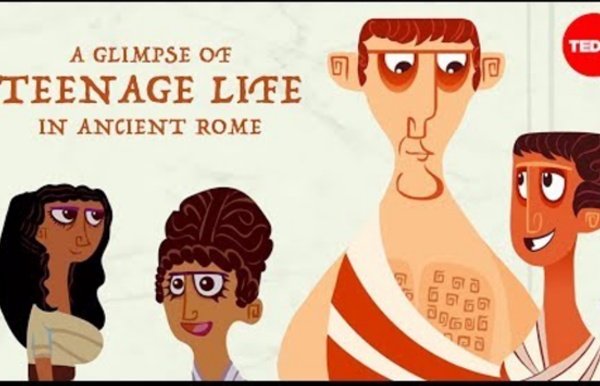



http://www.youtube.com/watch?v=juWYhMoDTN0
Related: antiquitéAncient Egypt - Kids History Videos, Games and Lessons that Make Learning Fun and Easy Ancient Egypt for Kids Ancient Egypt was a civilization that thrived for over 3000 years along the Nile River in northeastern Africa. It was the longest-lived civilization of the ancient world, reigning from 3150 BC to 30 BC. The ancient Egyptians developed a sophisticated writing system, a system of medicine and very effective irrigation and farming techniques. The Glory of Ancient Rome Notice: Object of class WP_Post could not be converted to int in /mnt/nfs-general/wordpress/wp-content/plugins/sfwd-lms/includes/course/ld-course-navigation.php on line 532 Preview video by clicking the “play” arrow Ciao Amici! Rome Reborn Images - Rome Reborn 2.2 - City Views An aerial view of the city center seen from the east. Visible are the Tiber River, Circus Maximus, Palatine, and Colosseum.
Four sisters in Ancient Rome - Ray Laurence Welcome to the world of Lucius Popidius Secundus, a 17-year old living in Rome in 73 AD. His life is a typical one of arranged marriages, coming-of-age festivals, and communal baths. Take a look at this exquisitely detailed lesson on life of a typical Roman teenager two thousand years ago. Freeborn women in ancient Rome were citizens (cives) but could not vote or hold political office. Because of their limited public role, women are named less frequently than men by Roman historians.
Ancient Greece - Kids History Videos, Games and Lessons that Make Learning Fun and Easy Ancient Greece for Kids The ancient Greek civilization thrived around the Mediterranean Sea from the 1100 BC to 146 BC. Known for its advances in philosophy, politics, religion, architecture, arts, government, and science, it is considered to have laid the foundation of the Western civilization and had a powerful influence throughout Southwest Asia and North Africa. The Greek civilization gave way to the Roman Empire in the 1st century BC. Ancient Rome {*style:<ul>*} {*style:<li>*} {*style:<h3>*}{*style:<a href=' Daily Life{*style:</a>*}{*style:</h3>*} {*style:<br>*} {*style:<br>*}Daily life in Ancient Rome often began with a light breakfast. Bread and water (or wine) would be served at home, or a wheat pancake could have been purchased on the way to work or school. Sometimes meat, fish, fruit, and other items may have been served, but not each day. {*style:<a href=' More {*style:<i>*}{*style:</i>*}{*style:</a>*} {*style:</li>*} {*style:<li>*} {*style:<h3>*}{*style:<a href=' Towns{*style:</a>*}{*style:</h3>*} {*style:<br>*} {*style:<br>*}Roman towns consisted of buildings and temples that they used to worship their gods.
How The World Looked When Jesus Was Born, According to Roman Geographers The world according to Strabo (Image: Paolo Porsia/flickr) Two thousand years ago, around the time that Jesus of Nazareth was born, the second Holy Temple was still standing in Jerusalem. The Great Pyramid at Giza was already 2,500 years old, but the Library of Alexandria was still around. In Rome, the Colosseum hadn’t been built yet. Ancient Rome - Kids History Videos, Games and Lessons that Make Learning Fun and Easy Ancient Rome for Kids Ancient Rome was a civilization that developed from a tiny settlement to one of the largest empires in the ancient world between the 10th and 1st century BC. The Roman Empire extended its political control over all of Italy, and at its peak, stretched from England to North Africa and from the Atlantic Ocean to Arabia.
Roman roads The ancient Romans built a vast network of roads, linking the far-flung Republic and Empire together in a unifying way that facilitated a more ready transfer of people, goods, and armies from place to place. As with other kinds of architecture, the Romans were scientific about their road-building. Roman surveyors used a groma, a set of wooden pieces in the shape of a cross that had lead weights on the ends. Lining up the weight hanging off one piece of wood with the piece hanging off the one in front guaranteed a straight line; from that, workers could put wooden posts in the ground and then build the road along the line. The Romans much preferred to build roads in a straight line, no matter what was underneath. The Mystery of the People Frozen in Time Pompeii is one of the most iconic monuments of the Roman world. Millions of tourists go there every year to see the remains of this ancient city destroyed by the volcano Vesuvius. What makes Pompeii so special are its remarkable relics. They're not statues but remains of people frozen in the last few seconds of their lives.
Roman baths The Bath: Focus of Roman Life One of the main points of focus in Roman life was the bath. The Romans bathed fully only once a week. The Great Wall of China (2007) It was the most ambitious building project ever attempted in the history of mankind. And its story has been almost impossible to tell - until now. Based on astonishing new archaeological finds and extraordinary first-person accounts, Great Wall of China tells the story of one of the greatest wonders the world has ever known.
Remus and Romulus The city of Rome has a legendary origin story involving twin brothers, Remus and Romulus. Various versions of this story exist, and the details differ sometimes significantly; however, the stories share some basic details and all the same way, with the triumph of one brother over another and the founding of the City of Rome. As the story goes, a woman named Rhea was married to Mars, the god of war.